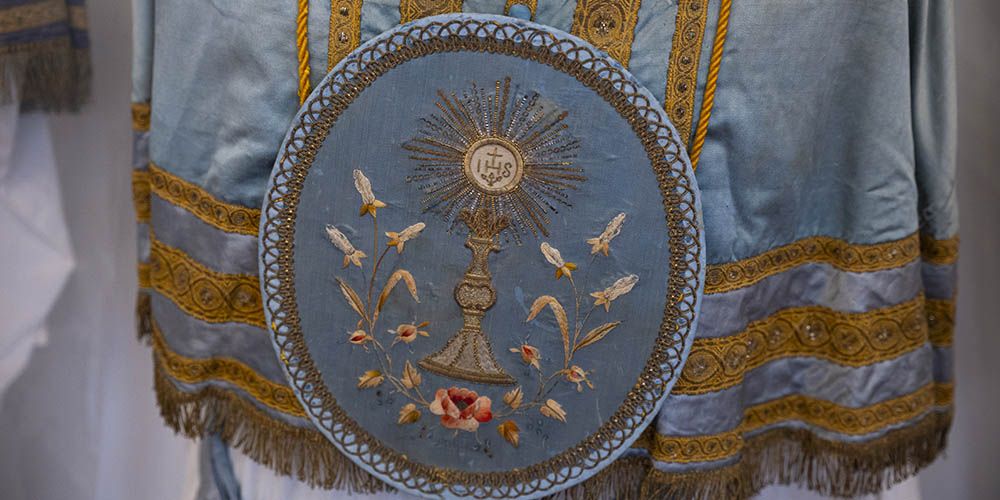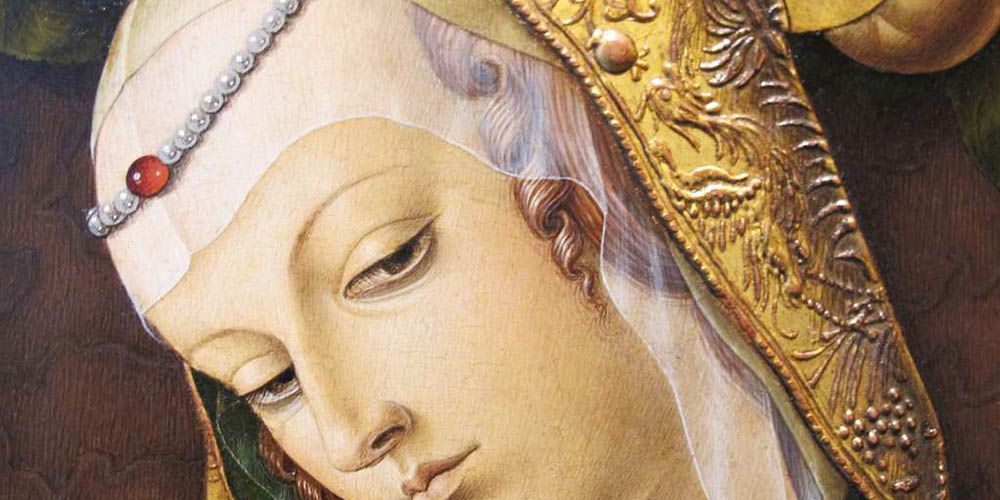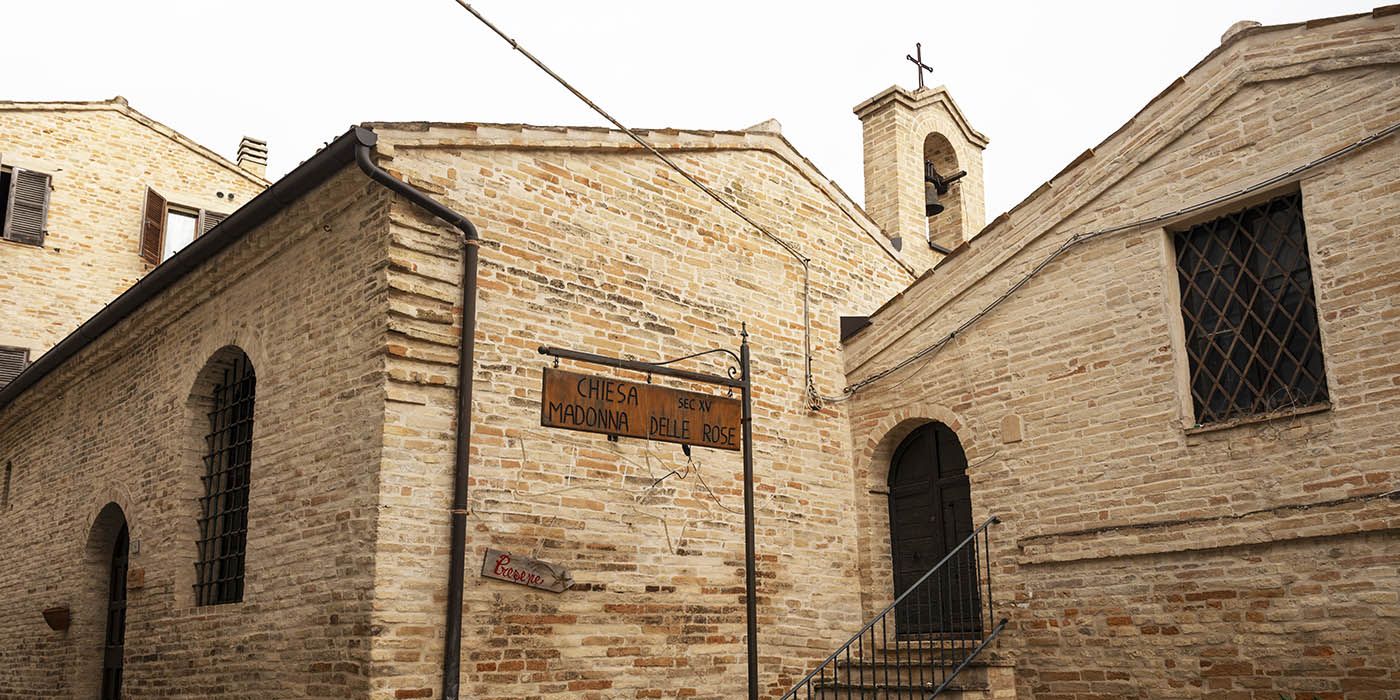The small villages of the Marche region offer surprises and treasures, historical and artistic excellence of inestimable value. In this article we will take you to discover a small church in the heart of the town of Torre San Patrizio, one of the oldest and most significant sacred places in the village, which houses a masterpiece of fifteenth-century art, La Madonna del Latte, signed by Pierpalma da Fermo, a lively and refined fifteenth-century painter, whose prolific pictorial production throughout the area has recently been reconstructed.
If you are an art enthusiast or looking for off-the-beaten-track adventures, at the end of the article we have studied a suggestive and fun idea for you, follow a short artistic itinerary in the footsteps of Pierpalma da Fermo, starting right from the tiny church of the Madonna delle Rose in the village of Torre San Patrizio.

The Church of Madonna delle Rose in Torre San Patrizio: A Treasure Chest of Art and History

The Church of Madonna delle Rose represents one of the most significant and ancient sacred places in the town of Torre San Patrizio. A small architectural jewel dating back to the 15th century, restored to its ancient splendor thanks to recent restoration work, strongly desired both at an institutional level and by the entire local community, and made possible through the contributions and support of private individuals, confraternities and the parish itself. Inside there is an important fresco, which has been only recently finally attributed to its true author, a refined 15th century painter, very active in the Fermo area during the Renaissance period.
The fresco of the Madonna del Latte is one of those masterpieces that you come across almost by chance and that give moments of ecstatic observation. Inside the small church, in addition to the fresco by Pierpalma da Fermo, there are several valuable works such as the polychrome wooden sculpture reproducing the Holy House of Loreto, a particularly important symbol for the Marche region; the painting of the Madonna delle Rose by Luigi Fontana, from which the church takes its name; a Romanesque braided holy water stoup, of considerable value, made from a column capital. Inside the church are also preserved the ancient vestments of the Confraternity of the Santissimo Sacramento, owner and custodian of the property. The church represents the expression of the religious tradition of the town and is a place of prayer deeply felt by all citizens.
The fresco of the Madonna del Latte: a masterpiece of fifteenth-century art

You will find the fresco of the Madonna and Child Enthroned between Saint Nicholas of Tolentino and Saint Bernardino of Siena, above the Blessing Redeemer, also simply called Madonna del Latte, in a small niche, at the back of the little church of the Madonna delle Rose in Torre San Patrizio. It is a work of extraordinary importance, to be rightfully counted among the masterpieces of fifteenth-century art in the area.
The fresco dates back to 1466 and depicts the Madonna sitting on a throne breastfeeding the Child, with two angels throwing white and red flowers at her sides and the Risen Christ above her; two Saints, probably Franciscans, holding a red book in their hands are depicted next to her. At the base of the throne, under Mary's feet, there is an inscription bearing the date 1466 and the barely distinguishable signature of Pietro Alima, which thanks to careful reconstruction and study was finally traced back to Pierpalma da Fermo in 2011. The upper part of the fresco is the best preserved, with colors still visible, while in the lower part several parts have been lost. The fresco was subject to a recovery action, it was removed from the wall and reattached to a support that allows it to be protected from humidity.
Pierpalma da Fermo

Only recently, thanks to extensive research, has it been possible to reconstruct the entire pictorial work of the artist Pierpalma da Fermo, who for a long time had been linked to the non-existent name of Pietro Alima. Pierpalma da Fermo was a lively and refined painter, who in the second half of the fifteenth century monopolized the mural paintings of the entire Fermo area, managing to establish himself for the quality of his painting. Pierpalma was a pupil of Carlo Crivelli, one of the most fascinating personalities of the Italian Renaissance.
We know that Pierpalma was the son of an artist, the son of the master Ugolino da Milano, and had a brother: Lorenzo, also a painter, with whom he worked on a decoration in the Palazzo dei Priori in Fermo. Some documentary reconstructions present Pierpalma's life in lively tones, such as the discovery of a fine for a brawl in the square. A fiery personality that we find in the varied use of bright colors. The recent conquest of historical-artistic studies about the historical identity of Pierpalma da Fermo has allowed us to reconstruct the prolific pictorial production that extends over the territory of Fermo, Amatrice, Monte Urano, Loro Piceno, Monterubbiano, Piobbico, Pian di Pieca, Ponzano di Fermo, San Ginesio, Tolentino and Torre San Patrizio. The story of the attribution of the work of the Madonna del Latte to Pierpalma da Fermo concludes only in 2011 when the historian Matteo Mazzalupi, from a careful rereading of the signature, traced it back to the artist; before this it had initially been attributed to Pietro Alemanno and in 1985 to a non-existent painter of Albanian origin Pietro Alima.
Historical-artistic context: The 15th century in the Marche

All the Marche region are dotted with works of art of inestimable artistic and cultural value, a heritage of works that tells many stories. Artists such as Raffaello, Lorenzo Lotto, Carlo Crivelli, Giovanni Andrea De Magistris and Simone de Magistris are only the most famous and illustrious. The small villages of the Marche region are dotted with frescoes, paintings and canvases of exceptional artistic value, they represent real jewels and make the villages that host them, such as Torre San Patrizio, even more interesting from a historical and cultural point of view.
For the area of Torre San Patrizio, the artistic influence of the city of Fermo had considerable importance. In 1433 Francesco Sforza, after conquering the lands of the Marche, made Fermo the capital of a new state. The Sforza court settled in the Girifalco fortress and promoted various artistic construction sites in the city and throughout the Fermano area. A group of painters worked on the decorations of the Girifalco fortress, giving a significant boost to local painters. The presence of Carlo Crivelli, born in Venice and with an adventurous life, also had a significant influence in the area. After a stay in Dalmatia, he settled in Fermo in 1468. It is in this artistic context that Pierpalma da Fermo began, leaving us an invaluable artistic legacy.
How to get to the church of Madonna delle Rose

The advantage of small towns is to reach all the destinations in a short time, this allows you to make your visit in complete calm, without rushing and without hitches.
Getting to the church of the Madonna delle Rose is very simple, if you are in the central square of Torre San Patrizio, Piazza Umberto I, you will reach the church in a few minutes, you have to take via Giuseppe Mazzini; then, turn right and take Via Roma, again on the right you will find Via Giuseppe Garibaldi and at number 48 the Church of the Madonna delle Rose.
Small artistic itinerary: on the trail of Pierpalma da Fermo

In this last paragraph we want to offer you a fun idea, whether you are an art enthusiast or looking for a different adventure, we suggest you travel by car and follow a small artistic itinerary, following the trail of the artist Pierpalma da Fermo. The starting point is artistic, but clearly traveling offers many experiences, let yourself be surprised by what you encounter in these places.
We start from the village of Torre San Patrizio with the fresco of the Madonna del Latte, in the small church of the Madonna delle Rose. Leaving Torre San Patrizio behind you, follow the signs for the Chiaravalle di Fiastra Abbey, this abbey where you can breathe a beautiful atmosphere, represents the most important monastic building in the Marche, here you will find some valuable frescoes by Pierpalma inside the main chapel. From the Abbey of Chiaravalle di Fiastra, continue your journey to the magnificent city of Fermo, here we have two frescoes attributed to Pierpalma that take up the theme of the Madonna del Latte, in the Oratory of Santa Monica, Madonna breastfeeding the child and in the church of Sant’Agostino on the same subject. We conclude our little tour in search of Pierpalma da Fermo, in the enchanting town of Monterubbiano, and precisely in the church of San Giovanni, where we find the fresco of the Mystical Marriage of Saint Catherine of Alexandria, here you can clearly see the hand of the refined painter that was Pierpalma da Fermo, you too can try to trace the similarities. Have a good trip in search of treasures!

Progetto "Visit Torre San Patrizio" per la valorizzazione del territorio e delle eccellenze locali, CUP B41J24000170002, finanziato per 36.885,25 € da FESR 2021-2027, ASSE 1, azione 1.2.2 intervento 1.2.2.2 Servizi digitali integrati
About the author
Written on 13/11/2024



Chiarastella Campanelli
In the small church of Madonna delle Rose in Torre San Patrizio a masterpiece of fifteenth-century art, signed by Pierpalma da Fermo.